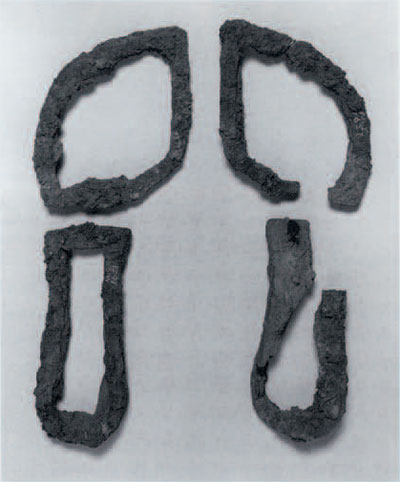
In October of 2002, three new galleries will join “The Ancient Greek World” to form a suite devoted to the cultures of ancient Greece and Italy. In developing “The Etruscan World,” we had the wonderful experience of working with one of the most important Etruscan collections in the country. Although many of the objects are well known, there are still discoveries to be made.
At first glance, the fragments—seven heavily corroded iron pieces—seemed unremarkable, but they came together to form the frames of a pair of Etruscan sandals. This was an exciting discovery. Etruscan sandals, with their platform soles and gilded laces, were famous in antiquity, prized by Etruscan and Greek women alike. And women took these favorite possessions to their graves. Many pairs, some even retaining the imprint of the wearer’s toes, are found in 6th century BC Etruscan tombs. A hinge at the instep made the back section flap, and the click-clack sound was part of the appeal. Where did our sandals’ owner show off her fancy footwear? In platform shoes like these she walked on city streets, not country lanes, and apparently it was the streets of Vulci, one of the principal Etruscan cities. And that was part of the discovery, too.
With us when we first identified our sandals was Richard De Puma, an Etruscan scholar from the University of Iowa. He had published some of the Etruscan material in the Field Museum in Chicago, and there he had found documentation, including a photograph, for a tomb group from Vulci. He had not, however, been able to locate all the objects that appeared in the photograph. When he saw our sandal frames, he recognized them as the very ones arrayed in the middle of that picture. And how did part of this tomb group end up in Philadelphia and part in Chicago? In the fall of 1896, a shipment of crates from Italy arrived in Philadelphia, with objects that would form the nucleus of the Museum’s Etruscan collection. The Museum’s agent in Rome, Arthur L. Frothingham, Jr., was also working for the Field Museum and had dispatched a shipment to Chicago at about the same time. Although he was generally careful to keep objects from a single tomb together, somehow the group got separated and some pieces went to Chicago, while others came here. So now, our iron fragments have turned out to be Etruscan sandals once worn by a woman of Vulci, and they will take their place and tell their story in our new Etruscan gallery.
Ann Blair Brownlee
Senior Research Scientist in the Mediterranean Section and co-curator of the Etruscan and Roman exhibitions
Jean MacIntosh Turfa
Lecturer, Bryn Mawr College, and consultant for the Etruscan and Raman exhibitions
